
Let me give it to you straight.
You might gain weight while you’re in college or university.
Hell, maybe you’ve already gained some weight and that’s why you’re reading this.
Well, there’s no shame.
Weight gain in college is actually pretty common.
If you’ve already gained some weight, I bet there’s 15 other people in one of your classes that gained some weight too.
However, you shouldn’t feel hopeless or trapped because just as easily as you gained it…
… you can lose it.
That’s why I created this Ultimate Guide to Losing Weight in College so you don’t become a victim of the dreaded “freshman 15”.
And I’m going to explain exactly how you can lose that weight very simply…
…but first, let’s address why you may have gained weight in the first place.
Why Do People Gain Weight in College?
A lot of people are actually very skeptical about this idea that college students are chunking up all around the country… but it’s true.
In fact, a study conducted by researchers at Auburn University tested the premise of the “freshman 15” and found that it’s all too common.
These researchers followed the progress of 131 students of 4 years and discovered that a whopping 70% of them gained an average of 12 lbs (with some gaining as much as 37 lbs).
Whoa.
So what did these researchers say the causes were?
- Late night study habits
- Vending machine snacks
- Picking unhealthy food in college cafeterias
- Lack of activity
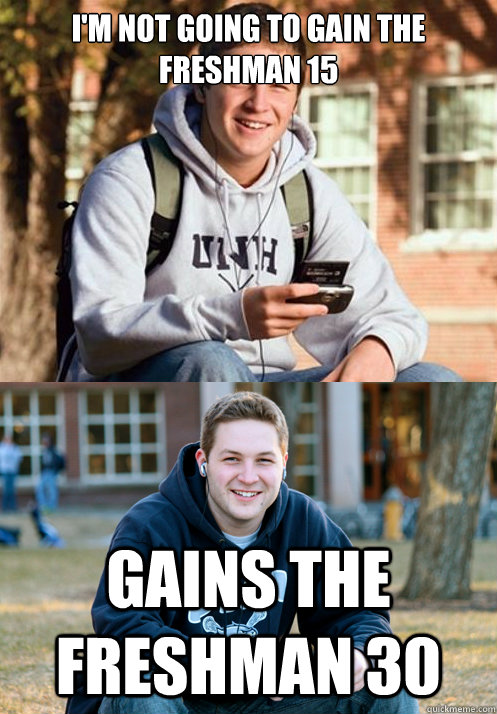
It’s almost like when you step onto campus, you’re entering a breeding ground of body fat.
However, the situation isn’t as dismal as you might think as long as you focus your attention on the right thing…
The Most Important Factor for Losing Weight in College
Sure, there are a lot of ways to tackle weight loss that you’ve probably heard of…
- Cardio
- “Going paleo”
- “Eating keto” (whatever that means)
- Breaking up with your highschool sweetheart
(You really won’t believe how easily you lose weight with that last one.)
But in all seriousness, the most important thing that you can do to actually start real weight loss is to create a caloric deficit.
What’s a Caloric Deficit (and Why Do I Care)?
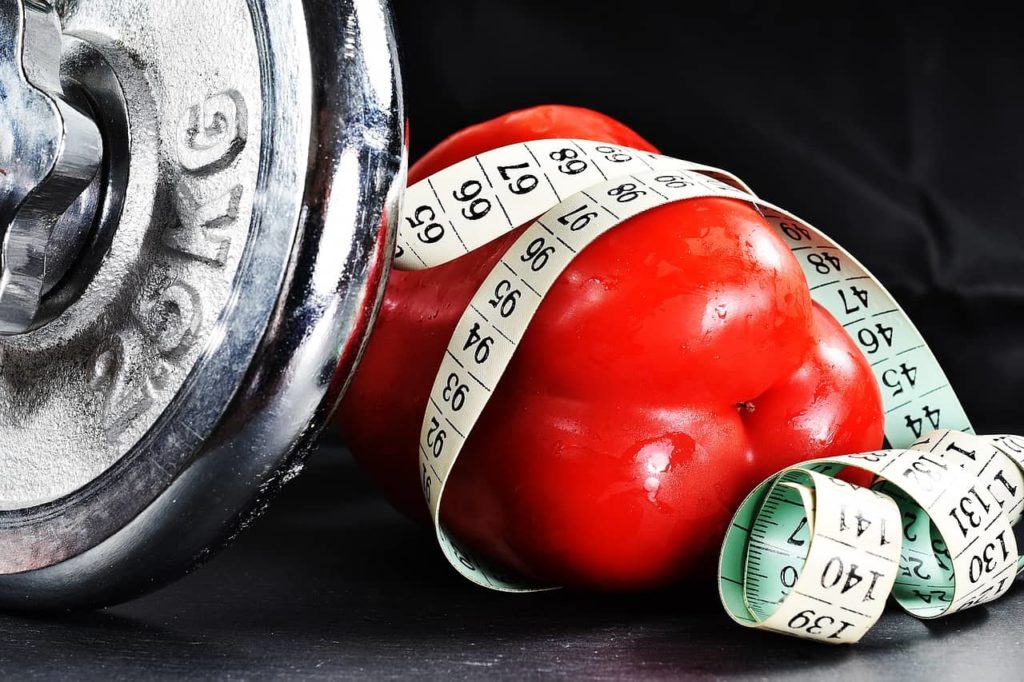
A caloric deficit is a shortage in the calories consumed in comparison to the calories your body needs to maintain its current weight.
Let me explain…
By whatever means you choose to do it, if your body is receiving or burning more calories than it needs to maintain what you physically look like right now… then you’re going to lose weight.
Now here’s the most important part.
You’re probably already thinking to yourself,
Oh so I just have to do a bunch of cardio every day to burn off the calories.
Actually, that’s the wrong way to approach it.
Research has shown that using exercise as the primary way of creating a caloric deficit usually leads to weight loss slowing down over time (and in many cases gaining the weight back).
That’s why I’m going to recommend that you take the more reliable, long term approach and fix your diet instead.
So instead of sweating away the pounds (and eventually hating your life on a daily basis), you’re going to simply eat less.
“But how much less?” you may be asking. Let’s calculate it.
How to Calculate a Caloric Deficit in Your Diet: 3 Steps
So now that I have you convinced that you should change your diet instead of adding more cardio chaos to your life, here’s a 3 step process to determine how many calories you should eat each day to start losing weight in college.
1. Calculate Your Maintenance Calories
First, you need to calculate your basal metabolic rate (BMR) or how many calories your body needs to maintain your current body weight with physical activity included.
A very reliable method for calculating this is by using the Harris-Benedict equation that was originally published in 1919 and then revised for accuracy in 1984 and then again in 1990.
Men
BMR = (10 × weight in kg) + (6.25 × height in cm) – (5 × age in years) + 5
Women
BMR = (10 × weight in kg) + (6.25 × height in cm) – (5 × age in years) – 161
For example, if you’re a 20 year old male, that’s 5’ 10” (177.7 cm) and you weight 200 lbs (90.72 kg), then your calculation would look like this:
1922 = (10 x 90.72) + (6.25 x 177.7) – (5 x 20) + 5
If you’re a female that’s 21 years old, is 5’ 4” (162.46 cm) and you weigh 170 lbs (77.11 kg), then your calculation would look like this:
1520 = (10 x 77.11) + (6.25 x 162.46) – (5 x 21) – 161
Multiply by Your Average Activity Level
After you’ve calculated out your BMR, then you need to account for all the calories you burn doing your normal physical activities.
This gives you your Total Daily Energy Expenditure (TDEE).
So, pick the description that most accurately represents you and multiply your BMR by the amount.
| Description | Multiplier |
|---|---|
| Sedentary (sit on your ass all day) | 1.2 |
| Light activity (some exercise or training 2-3x per week) | 1.375 |
| Moderate activity (exercise or training 4-5x per week) | 1.55 |
| Lots of activity (exercise or training 6-7x per week) | 1.725 |
| Insane activity (you’re never not training) | 1.9 |
This makes the formula look like this…
TDEE = BMR x Activity
For example, if you’re that 20 year old guy and you sit on your ass all day, then you would multiply your BMR by 1.2 like this:
2306 = 1922 x 1.2
And if you’re that 21 year old female from the other example and you partake in some moderate activity throughout the week, then you would multiply your BMR by 1.55 like this:
2356 = 1520 x 1.55
Now we get to the part where we actually think about “losing weight”…
2. Determine How Quickly You Want to Lose Weight
Now this might sound like a trick question because if you ask anyone, “Hey, how fast are you interested in losing weight in college?”…
…they’ll usually reply with “Um, as fast as possible… duh.”
Well, that’s not what I’m asking here in this step.
In this step, you’re actually going to make a judgement call on the state of your body right now and determine a safe amount of weight that you can lose per week.
See you don’t want to lose weight too quickly because then it’s going to be very difficult to adjust your diet later when the weight loss stops.
You’ll have to drop your calories even more than you originally did and if you started with a drastic cut, then it’s only going to get worse.
You also don’t want to lose weight too slow if you can help because this can eat away at your motivation if you’re just waiting and waiting without any results to keep you going.
So in the chart below, you can see for each weight classification, there’s a recommended, safe rate of weight.
Identify your current body type from the chart below.
| Weight Class | Rate of Weight Loss Per Week |
|---|---|
| Obese | 2-3 lbs |
| Overweight | 1-2 lbs |
| Average | 1 lb |
| Already lean | < 1 lb |
3. Drop Your Calories According to Your “Rate of Weight Loss”
OK, so now that you identified how many lbs you can safely lose each week, it’s time to use that amount to determine the number of calories you should eat per day to start seeing weight loss.
A single pound of fat takes about 500 calories per day (3500 for the week) to form in your body.
So, the first thing you’ll do is multiply your rate of weight loss from above by 3500 calories and then divide by 7.
For example, if you classified yourself as “overweight” and want to lose 1 lb per week, then your calculation would look like this:
500 = (3500 x 1) / 7
Finally, take that number and subtract it from your calculated TDEE.
Fat Loss Calories = TDEE – Body Fat Calories
If you were that 20 year old guy again, your fat loss calories would turn out like this:
1805 = 2306 – 500
Congratulations! You just calculated how many calories to start eating to see weight loss.
Special Note: These calculations sound great, but all calculations are just estimates.
Everyone is different and it’s almost impossible to nail down exactly how much someone needs to eat to lose a specific amount of weight without knowing things like their:
- Medical history
- Relationship with food
- How their body retains water
- The intensity of activity someone claims they do
- And a bunch of other stuff
So all I’m saying is don’t be afraid to make a slight adjustment after making these calculations.
Start eating the amount you calculated, wait a couple weeks, evaluate how much weight you’ve lost and then adjust if things are not going as expected.
Foods to Eat to Lose Weight
Now, that we got your daily calories out of the way, let’s talk about what you should eat to start losing weight in college.
You’ll be happy to know despite what you’ve thought in the past, you can pretty much eat whatever foods you want and still lose weight.
…as long as you stick to your calories.
However, there are still very valid reasons to pick certain foods over others to make the process easier and better suited to your body composition goals.
So, let’s go through ‘em…
Eat High Protein Foods to Maintain Muscle
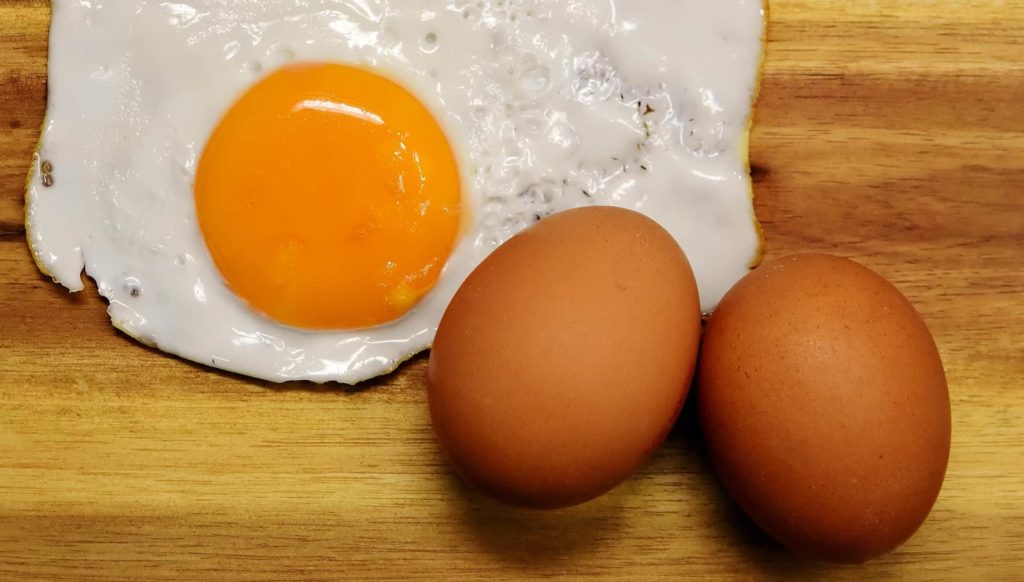
Of the three macronutrients (proteins, carbs, and fats), protein is the most satiating.
(It’s gonna make you feel full.)
So, including a considerable amount of protein in your diet is gonna be in your best interest since it’ll keep your ravenous appetite at bay.
The evidence of this is in various studies including this one performed on obese men and this one performed on women.
If your goal is to just “lose weight” and you don’t care where the weight comes from, then consuming around 0.5 g of protein per 1 lb of body should be sufficient.
On the other hand, if your goal is to lose primarily “body fat” and preserve existing muscle mass, then you should consume about 1 g of protein per 1 lb of body weight.
Good sources of protein include:
- Milk
- Chicken
- Fish
- Beef
- Eggs/egg whites
- Cottage cheese
- Greek Yogurt
- Cheese
- Almonds
Consume Moderate Fats to Keep Your Sanity
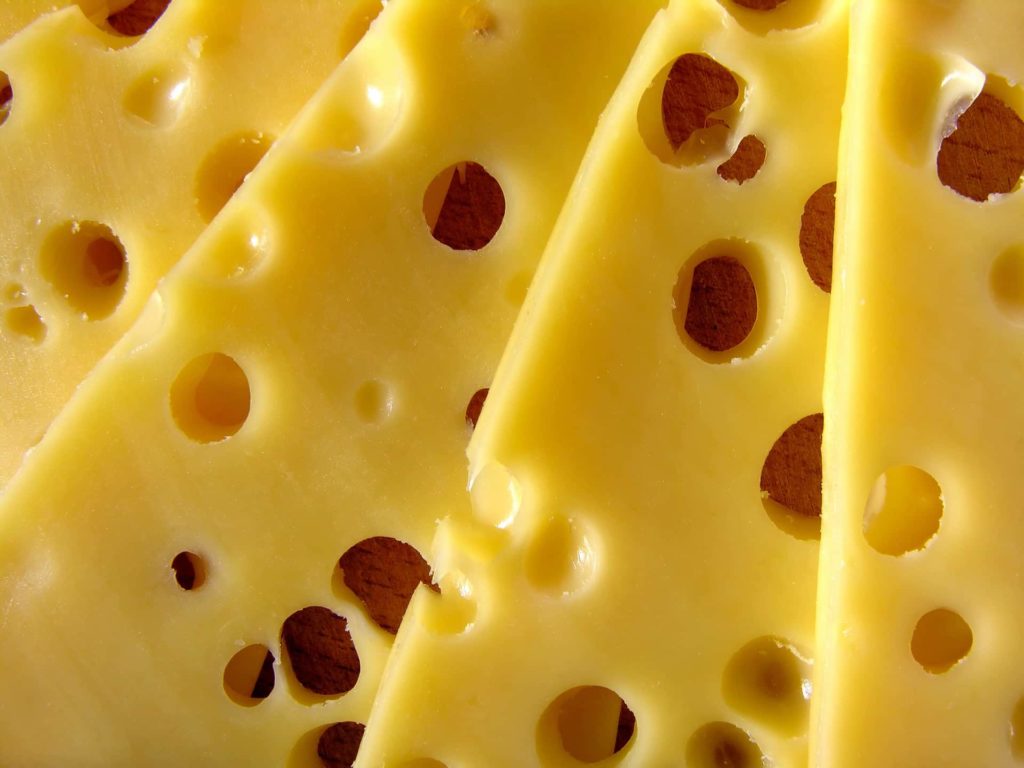
Now when you talk to most people about dieting, protein gets all the glory, but there’s a little controversy on the role of fats and carbs.
Well, when it comes to fats, they play an important role in…
- Maintaining your sex drive
- Balancing your hormones
- Brain function
So if you think you’re going to go extremely low fat…
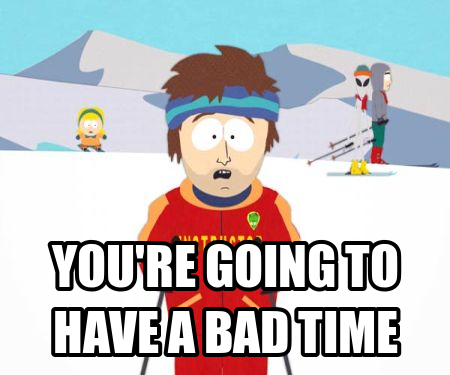
A good baseline is to consume 20-30% of your total daily calories from fat.
Here are some good sources of fat to include in your diet for losing weight in college…
- Butter
- Cheese
- Avocados
- Eggs
- Fatty cuts of meat
- Extra virgin olive oil
- Coconut oil
- Peanut butter
Fill the Rest of Your Calories with Carbs
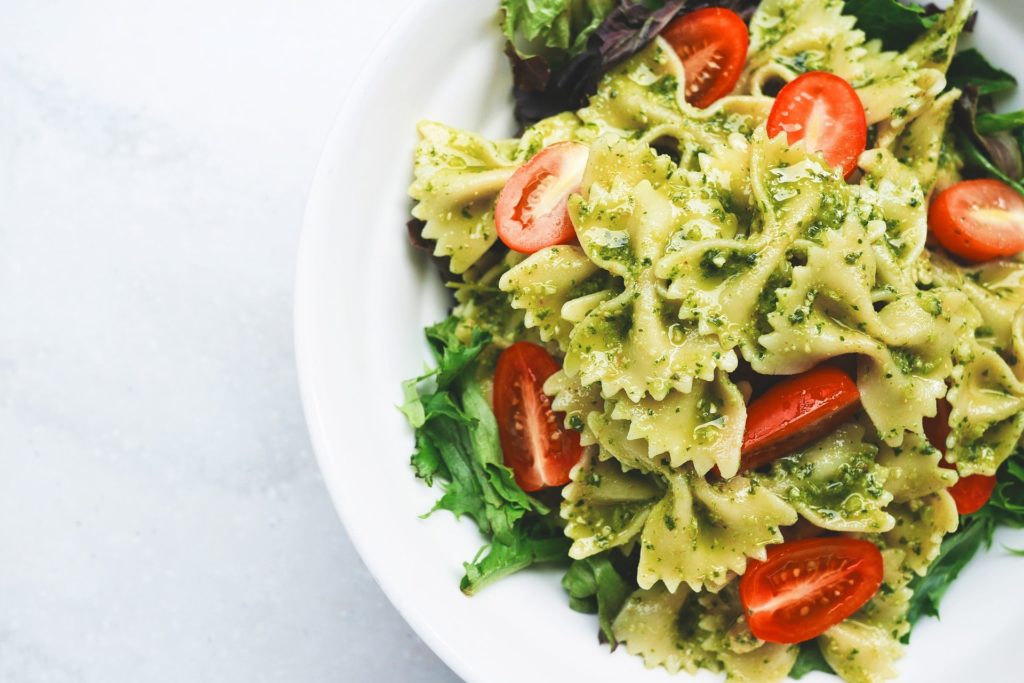
After you’ve decided how much protein and fat you’re going to consume, the only that’s left are carbohydrates.
There are carbs in just about anything, but these are some good sources to get you started…
- Bread
- Oats
- Fruit
- Pasta
- Rice
- Cereal
Now it always goes without fail that after I give my recommendations on macronutrients to lose weight, I always get questions like this…
Can I go “low carb”? Can I go “low fat”?
Sure you can.
When it comes to pure “weight loss”, it doesn’t matter quite as much if you choose to reduce your overall calories from carbohydrates or fats.
Whatever mix helps you to stick to your diet is the most important thing.
On the other hand, if you’re trying to make an effort to preserve muscle mass, then you need to be a little more careful with your ratios.
I wrote a previous post that addresses this here – The Best Diet for College Students to Get Shredded.
Additionally, here’s a good scientific explanation of balancing your fats and carbs in this video from PictureFit.
Easy Healthy Meals for College Students
So now that you’ve figured how much you’re going to eat and some macronutrient guidelines for losing weight in college, the next question is…
“How do you make this stuff?”
Well it’s not as difficult as you might think, especially if all you have access to is a microwave.
That’s why I really like these 7 Easy, Healthy Microwave Recipes from FitMenCook.
This should give you some ideas, plus it’s a great start if you’re living in a dorm right now.
But what about things to eat between classes?
Healthy Snacks for College Students
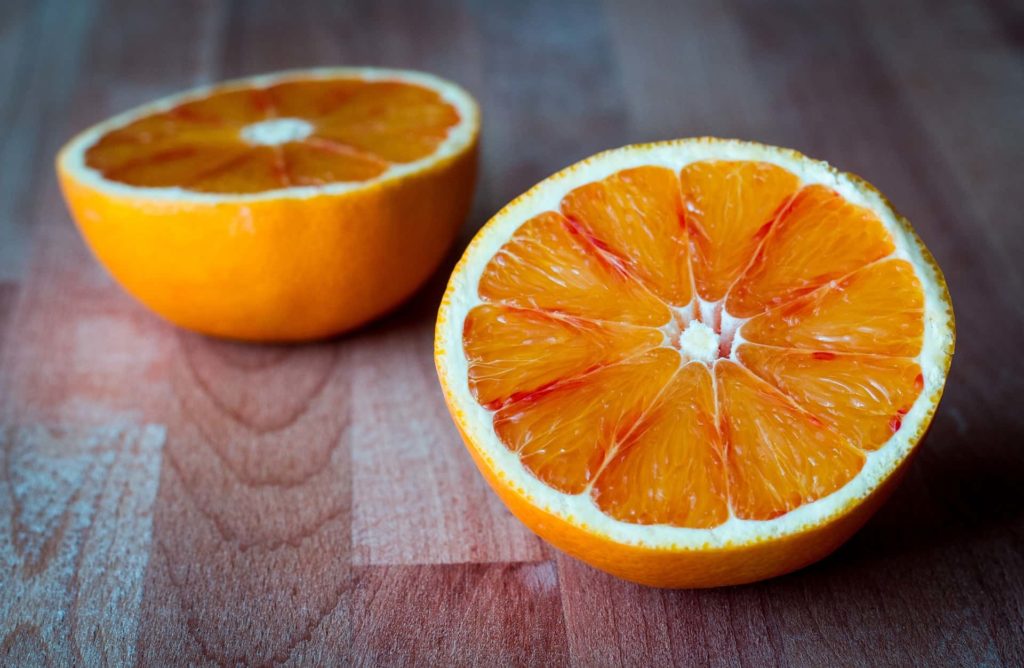
OK, so I’ll be blunt and say that I think snacking is a plague on society.
Honestly if most people just stopped eating when the meal was over, more people would lose weight.
…but I realize that I live in the real world where you might have a ravenous appetite and you’re still going to think that when you’re hungry that you need to eat something.
If that’s the case, then I wouldn’t be doing my job if I didn’t give you a few good student snacking options…
1. Protein Shake
Just carry around a scoop or two of your favorite protein powder (I prefer Optimum Nutrition Gold Standard or PEScience) in a shaker cup.
And next time you pass by a water fountain, fill it up and chug it down for a quick dose of protein.
There’s nothing easier than that, plus protein will help to deter you from having any more snacks in the near future.
2. A handful of almonds
Again, this is a good source of simple protein and you can buy in store almost anywhere.
Just carry them around in a Ziploc bag and pop’em in your mouth when you feel the need to snack.
3. A piece of fruit
Are you beginning to see how “old-school “I am with these suggestions for losing weight in college? lol
Really there’s nothing like eating some old-fashioned whole foods including a piece of regular fruit like an apple or a banana to stifle your appetite and give you a little jump of energy to keep going through the day.
4. Celery sticks or carrot sticks
Now the reason I like to carry around celery sticks or carrot sticks is because they are virtually 0 calories.
In reality there may be one or 2 calories, but it’s so low it’s not even worth counting.
So those are my primary suggestions having to do with nutrition and your diet to start losing weight in college.
Now we can get on to the fun stuff that you think you need to do in order to lose weight which is exercise…
However, I’m not going to give a suggestion that you’ll find on most “weight loss” websites…
Losing Weight in College with Strength Training (Not Toning)
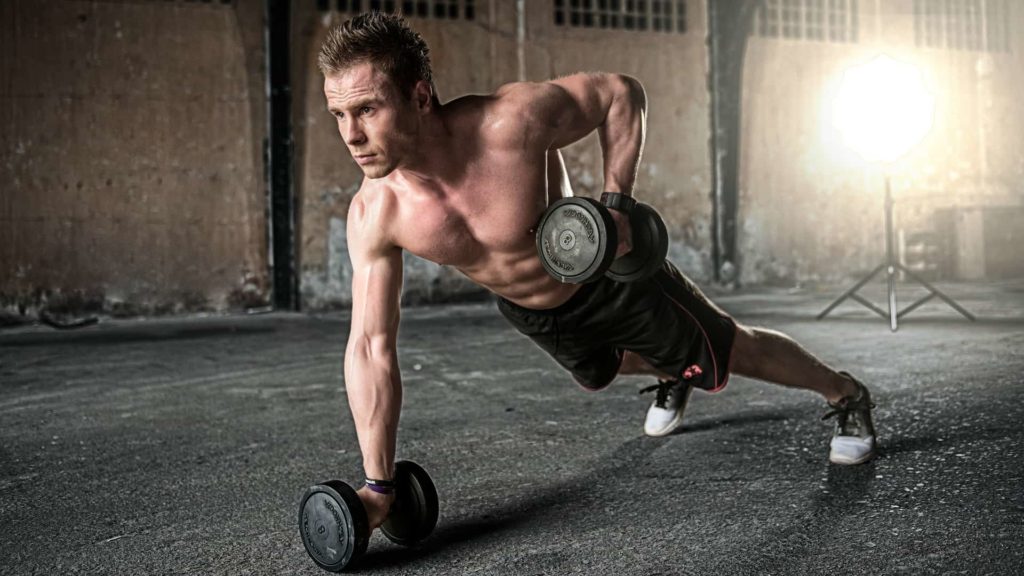
You may be staring at your phone wondering why I don’t recommend cardio as the primary form of exercise for losing weight in college.
Well, cardio is good for more burning more calories and increasing the the gap in your caloric deficit (there’s no denying that).
However, strength training, overtime, conditions your body to become more efficient at burning calories in the first place.
It’s like putting money into a savings account versus an investment account.
Yes, the savings account is going to keep your money safe and work you incrementally towards your goals as long as you keep putting more money in.
On the other hand, the investment account is going to start generating more money for you even when you miss a transaction or two.
Strength Training is going to add more muscle to your body, increase your metabolic rate, and make your body more efficient at burning calories.
(This will make losing weight in college a lot easier.)
Here’s a great example in this interview between Starting Strength’s creator Mark Rippetoe and a novice trainee named Crystal who lost 100 lbs when she stopped focusing on weight loss and instead focused on building muscle and strength.
The Exercises to Include in Your College Student Workout Plan
Now when it comes to strength training, not all exercises are created equal.
That’s why, in order to minimize the amount of time you spend in the gym, and maximize your strength gains, you should focus on compound lifts like these…
Squats
In case you didn’t know, there are a number of different kinds of squats like front squats, high bar squats, low bar squats, goblet squats, etc.
However, I’m a big advocate of low bar back squats which use the barbell and works a ton of major muscle groups like quads, hamstrings, glutes, abs, and lower back.
That’s why you can trust this low bar squat tutorial by Mark Rippetoe presented on the Art of Manliness YouTube channel.
Bench Press
The bench press is the universal “bro“ exercise, but that’s because it’s excellent at developing upper body strength.
This particular lift is going to work your chest, triceps, shoulders, and abs.
You can check out my instructions on how to bench press, but here’s also a great tutorial video.
Deadlift
The deadlift is one of the most notoriously misunderstood exercises and it’s probably just because it contains the word “dead” in the title.
However, this exercise is excellent at building lower body strength, burning a ton of calories (excellent for losing weight in college), and conditioning your ab muscles to handle very heavy loads.
(Plus, it’s an easier exercise to progress quickly and you can look pretty bad-ass lifting a bunch of plates early in your lifting career.)
Shoulder Press
Another important muscle group to work are your shoulders for all the upward lifting you do in real life like putting things on shelves, raising the roof, etc.
(Plus, one of the most common things that women say spurs physical attraction in men is having wide shoulders.)
So, the best exercise to properly work those shoulders is the standing shoulder barbell press as shown in this tutorial below.
Note: You can do seated presses if you have to, but given the option you should go with the standing version because it works more muscle groups.
Chin-Ups/Pull-Ups
Personally I think chin-ups/pull-ups are one of the best upper body exercises for your biceps, forearms, lats, and abs.
I’m also a bit of a Jordan Syatt fanboy once I landed this interview with him months ago and his video on How to Get Your First Chin-up is a great representation of his expertise as a strength coach.
Note: As you start losing weight in college, you’ll get more effective at performing this exercise.
Rows
To finish off your strength training routine, you should include a horizontal row to work your upper and lower back, forearms, and abs.
I’ll tell you right now that are a TON of row variations, but for the purpose of loose consistency, here’s another good tutorial on the barbell row from our favorite strength coach, Mark Rippetoe.
Popular Strength Training Programs
So now that you’ve seen the kind of exercises you should do for building muscle while you’re losing weight in college, here’s a short list of effective strength training programs to get you started.
And the reason I picked these specific programs is because they’re short, but still very effective at building strength and muscle.
As a student, you don’t have a lot of time to screw around in the gym and that’s why these programs are winners…
1. Starting Strength
Starting Strength is widely considered the most popular novice weightlifting program ever and its author, Mark Rippetoe, is someone I greatly admire.
The official Starting Strength book is an incredible resource that covers the technical aspects of the program and the exercises and I’d even go as far to say that it should be recommended reading for all serious lifters.
The program starts very simply broken into two workouts (A and B) that are alternated across 3 training days each week.
| Workout A | Workout B | ||
|---|---|---|---|
| Squats | 3 x 5 | Squats | 3 x 5 |
| Shoulder press | 3 x 5 | Bench press | 3 x 5 |
| Deadlift | 1 x 5 | Deadlift | 1 x 5 |
So your week would look like this…
| Monday | Wednesday | Friday |
|---|---|---|
| Workout A | Workout B | Workout A |
Then next week you would alternate the training days the opposite way going like this:
| Monday | Wednesday | Friday |
|---|---|---|
| Workout B | Workout A | Workout B |
There are a few phases to the program that later incorporates power cleans and chin-ups, but if you’d like to know the details you should check out the official Starting Strength website or again, read the book.
2. Greyskull LP
If you’re looking for a novice training program that allows for a little specialization, then you should try out the Greyskull LP by John Sheaffer (aka Johnny Pain).
I’ve ran this program before and it not only gives you options and “plugins” to customize the program to meet your goals, but it’s designed in a way so you can keep making progress for a very long time.
Just as an example, here’s the program I ran that allowed me to build overall strength with emphasis on my puny biceps.
| Monday | Wednesday | Friday | |||
|---|---|---|---|---|---|
| Bench press | 3 x 5+ | Shoulder press | 3 x 5+ | Bench press | 3 x 5+ |
| Chin-ups | 2 x 8 | Barbell curls | 2 x 8 | Chin-ups | 2 x 8 |
| Squats | 3 x 5+ | Deadlift | 1 x 5 | Squats | 3 x 5+ |
Note: The “+” after the 3 x 5 means that you do 2 sets of 5 reps and then as many reps as you can above 5 on the last set.
This allows you to not only go for weight PRs week to week, but when you reset after maxing out your progression, you can go for rep PRs too.
With the Greyskull LP, you’ll actually alternate the bench presses and chin-ups with the shoulder presses and barbell curls, but keep the squats and deadlifts on the same days each week.
But seriously, it’s a great program for losing weight in college and you should not only check out the official book, but visit Johnny Pain’s website, Strength Villain.
3. The Big 3 Routine by Ripped Body
The last strength training program I’ll recommend is The Big 3 Routine by Andy Morgan.
What’s great about this program is how simple it is to start.
Just see for yourself…
| Monday | Wednesday | Friday | |||
|---|---|---|---|---|---|
| Squats | 5 x 5 | Squats | 5 x 5 | Squats | 5 x 5 |
| Bench press | 5 x 5 | Bench press | 5 x 5 | Bench press | 5 x 5 |
| Deadlift | 5 x 5 | Deadlift | 5 x 5 | Deadlift | 5 x 5 |
It’s just 5 sets of 5 reps on squats, bench press, and deadlifts on Monday, Wednesday, and Friday.
Think you can remember that? Lol
The downside of this program is that you’ll outgrow it quickly when you keep adding weight for each workout.
It’s very difficult to keep up that pace after you’ve developed a strength foundation because your body won’t be able to recover fast enough.
But if this seems like your jam, you can check out the official program details here at Andy’s website, Ripped Body.
Now that I’ve addressed what sort of exercise I recommend for losing weight, I imagine you’re probably asking this in your head…
Can you lose weight without exercise?
Of course you can.
However, like I said above, strength training makes your body more efficient at burning calories since muscle mass requires more metabolic upkeep.
If you want to just adjust your eating habits that’s fine.
If you want to add strength training, that’s fine too.
Even if you want to just jump on the treadmill every other day, that’s your prerogative.
The most important thing is creating a system that you can stick to for a long time.
But how do you know if you’re actually losing weight in college?
How To Track Your Weight Loss
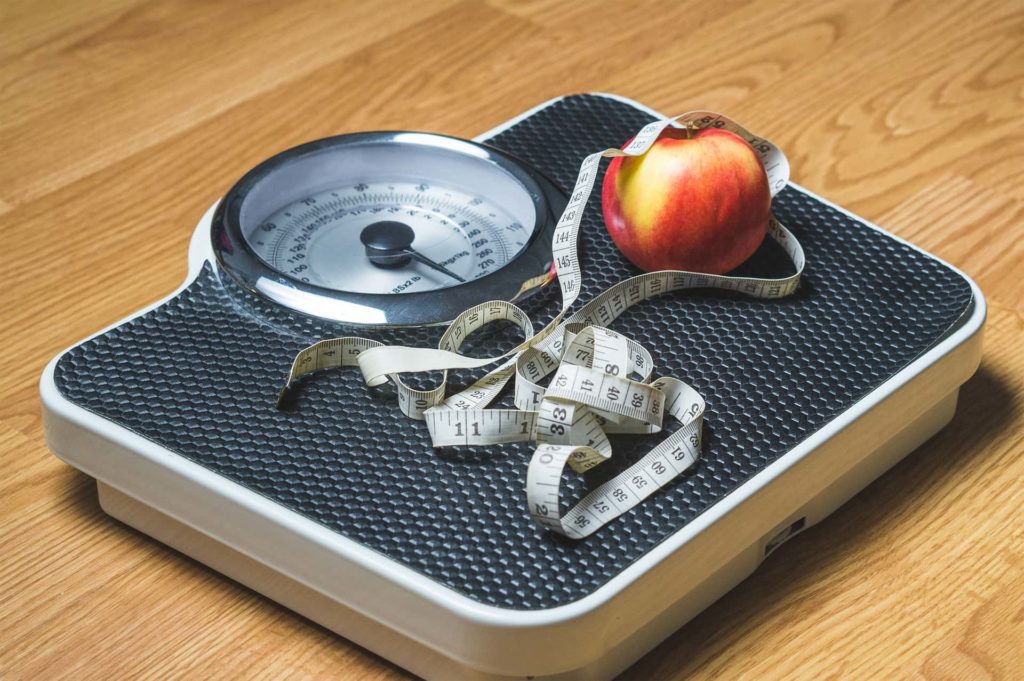
A big mistake that I’ve seen over and over again when someone says they’re going on a diet or they just started a new workout program is this…
…they don’t track anything.
If you ask this person, “hey, how much have you lost?”
They might respond with… “Oh, I know I’ve lost some because I look lighter in the mirror.”
Or… “I’ve been eating less so I know I’ve lost something.”
Hearing conversations like these let me know that the person just doesn’t know what to track, let alone how to track their weight loss accurately.
So let’s talk about what it is you need to track to confirm that you’re actually losing weight and not just wasting your time.
The 3 Most Important Progress Markers
1. Scale Measurements
First of all, your body weight is the most important marker to know if your weight is heading in the right direction.
(This measurement only tells part of the story though. More on that in a second…)
The most accurate way to take your body weight measurement is through this method.
- Weigh yourself every single day under the same conditions with as few clothes on as possible. The ideal time is right when you wake up after urinating.
- At the end of the week, take the AVERAGE of your entire week’s body weight measurements.
- Compare your weekly averages to determine if you’ve lost or gained weight.
The reason it’s important to compare weekly averages is because they minimize the impact of water fluctuation that create drastic shifts in weight one day to the next.
But your body weight measurement isn’t the only thing to record…
2. Waist Measurements
Your waist measurement tells the other part of the story.
For example, if both your body weight and your waist size are decreasing, then you know you’re losing weight in college.
However, if your weight stays the same (or even increases slightly), but your waist measurement goes down, then you’re actually gaining muscle and losing body fat at the same time.
The easiest way to measure your waist is with a tool like this.
It’s really simple to use and you get accurate measurements in both inches and centimeters.
But there’s one more way you should track your progress…
3. Progress Pictures
Taking pictures are important for motivational purposes when it seems like you’re not making any progress.
For example, you might be dieting for months and hit a sticking point that makes you question everything…
Is this really working?
Is this worth doing?
It’ll probably be OK if I eat a large pizza by myself tonight.
When these thoughts pop into your head, it’s a good thing to have pictures to remind yourself just how far you’ve come losing weight in college.
These are pictures that I’ve show on the site before that record my own journey.
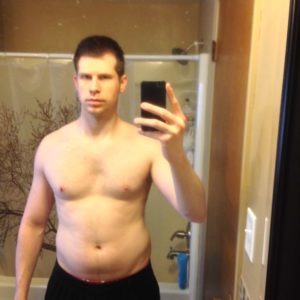

How long does it take to lose weight?
Here’s another question that you might be asking yourself.
And I get it… you want to know how long you have to restrict your calories or go to the gym (because it doesn’t sound like much fun).
First of all, when it comes to losing weight in college, once you catch on to it, you might really enjoy your new fitness lifestyle and the confidence that it gives you.
Second, if you set up your diet correctly, you should start seeing weight loss within the first few days.
Yea, it’s that quick.
However, you might not reach your goal weight for weeks, months, or even years because losing weight in college should be your 2nd priority (your grades coming first).
But as long as you stay consistent and hold yourself accountable for your actions, you’ll get there.
Oh, and I mentioned the word “accountable” for a reason…
Up until this point, I’ve presented you with some pretty powerful tips on losing weight and making your body more efficient at burning calories.
However, that doesn’t mean jack shit if you don’t do these things consistently.
That’s why you need to set up a system to hold yourself accountable.
Here are my recommendations…
3 Ways to Hold Yourself Accountable to Your Weight Loss Goal
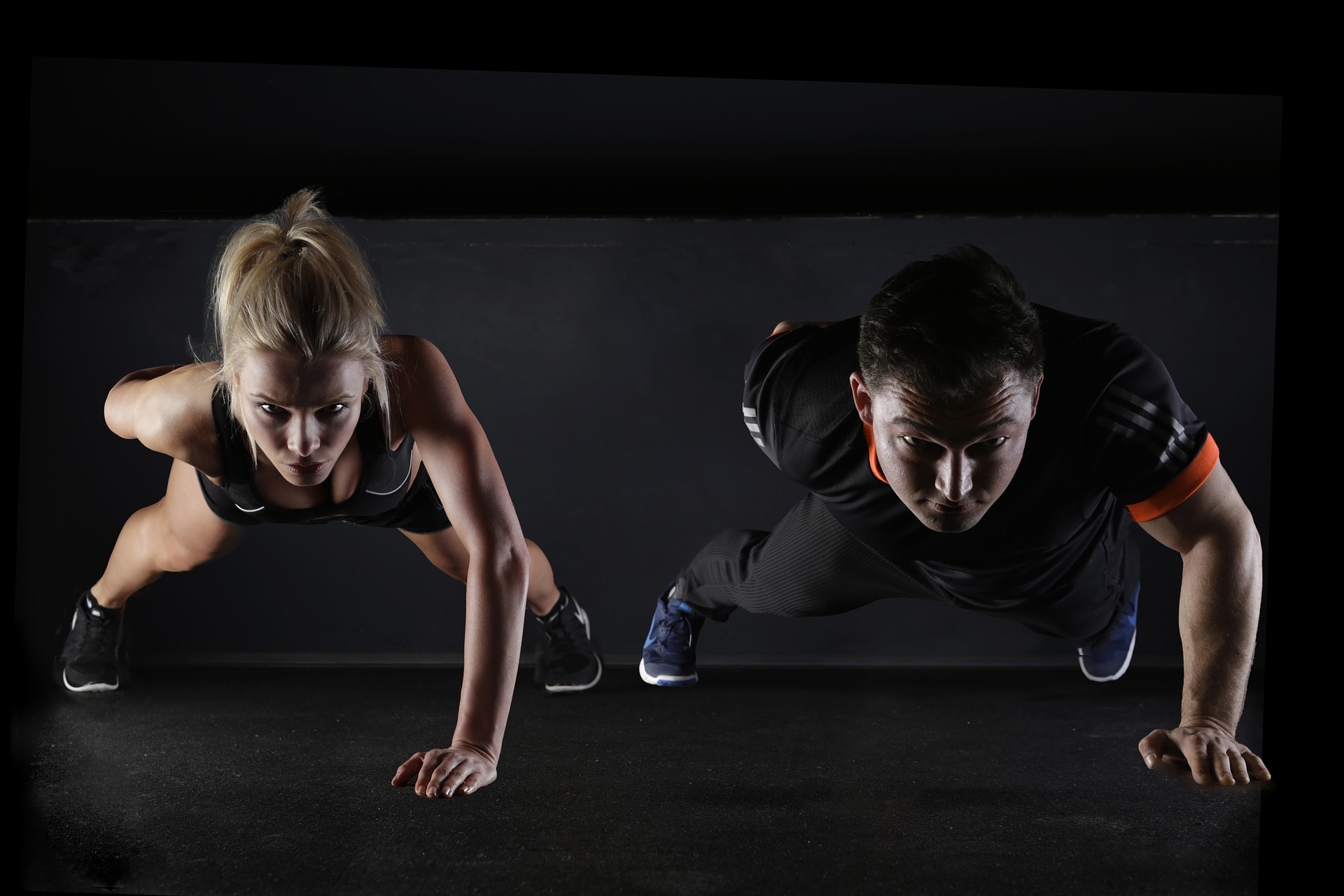
1. Tell Other People Your Goal
One way to sabotage yourself is to internalize your goal without letting anyone else know what you’re up to.
The reason it’s important to share it with others is so they can support you and your environment.
This also creates some subtle pressure on yourself to follow through if you’re like the average person who doesn’t like to disappoint others.
Plus, it’s important to share your weight loss goals with family members and friends because they may be way more supportive than you could have imagined which leads me to the next way to hold yourself accountable…
2. Get a Weight Loss Partner
Even more effective than just simply sharing your goal with someone is actually having a dedicated partner who will vow to move forward with you (especially if your goal is losing weight in college).
This is why Weight Watchers actually encourages people to come to their meetings to share stories and strategies.
Even if you think the meetings are lame, the accountability drives progress.
Yes, I’m sure there are people going to those meetings sharing stories about how they ate a whole apple pie one night or something like that…
…but some famous person I’m failing to remember once said…
No one reaches success alone.
And to an extent that’s true.
And that’s why I encourage you to…
3. Join an Online Weight Loss Group
With the power of the internet in the palm of your hands, there’s no excuse to not connect with others to help achieve your weight loss goals.
And they’re are some really effective weight loss groups out there like:
- Bodybuilding.com
- Fitocracy
- Subreddits like /loseit, /progresspics, and /fitness
People are constantly chatting, sharing, and pushing each other to become better versions of themselves.
You would be a fool not to engage if you felt you needed it.
How Are You Going to Start Losing Weight in College?

Whew… that was a lot.
I hope you learned something after reading this Ultimate Guide to Losing Weight in College and you’re ready to start putting it to work.
Just to wrap things up, here’s how you should get started…
- Calculate your daily calories
- Start finding foods and meals you can make that support your diet
- Start strength training
- Find someone (or a group) to hold you accountable
- Track your progress
But even before you do all that, I have some homework for you.
Leave me a comment and tell me what your weight loss goal is.
Simply putting it into writing will get a jump start on your motivation and trigger subconscious to start putting things into action.
